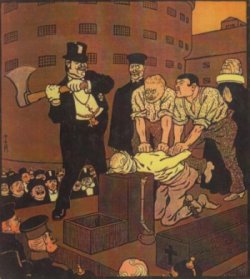THE EXECUTIONERS

|
|
Cartoon of a German executioner, 1899.
From: Richard J. Evans, Rituals of Retribution,
Oxford: OUP, 1996.
|
"r0ditionally, the executioners were socially ostracized, at times even made the subject of taboos, and general contempt mixed with superstitious fear – a mere touch from the executioner was deemed to be most dishonouring. In modern times, particularly since the second half of the 19th century, executioners tended to become government employees, with regular salaries and retirement benefits. Nonetheless, they remained socially isolated and were often forced to marry their colleagues’ kin, which lead to the creation of veritable dynasties of executioners. In Central Europe executioners were most often recruited from the ranks of knackers, an equally dishonourable occupation, as the knackers were in contact with carcasses and filth. By the end of the 19th century, the executioner became a celebrity in the modern sense of the word: his memoires (authentic or fictitious) were bestsellers and his private life was a subject of legitimate interest for the media. The stereotype of an executioner, fostered by the press, included several permanent features, of which a deep fondness for alcohol was not the least. In addition, an ideal hangman had a “heart of gold” and secretly agonized over the evil which he was forced by duty to inflict upon his brethren. The modern executioner cast away his colourful medieval costume and appeared on the scaffold in top-hat, frock-coat and white gloves. When travelling, he never parted from his leather bag in which he carried the rope and other paraphernalia of his trade.
In Yugoslavia between the two world wars, there were three official state executioners: Alois Seyfried, Florian Mauzner and Dragutin Karlo Hart. In the same period, two more individuals unsuccessfully applied for the job, namely Egidij Fux and Stanislav Todorovi�.
After World War Two, executions were performed by anonymous soldiers and policemen of the People’s Militia. A few who seem to have specialized in this line of work are known by name. They include Lazar Šaraba, Paja Jockov and Milorad Golubovi�.